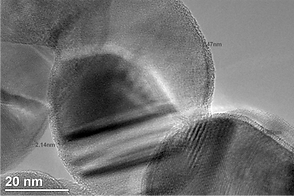


Requirements
The main challenge in the manufacturing of a nanocomposite powder made of aluminium microparticles and silicon carbide nanoparticles is to obtain both a stable and an homogeneous mixture. Besides, it is important to prevent particles deformation during the mixing process.
Nanoparticles possess a high Specific Surface Area which is at the origin of their particular behavior and their capability to highly impact the compounds they are in contact with. However, this high “surface of contact” leads to a very cohesive behavior linked with the presence of strong Van der Waals forces between them. Nanoparticles tend in that way to form agglomerates, making them ard to disperse with other particles.
It is important then, to find the right mixing process to break nanoparticles agglomerates, allow their homogeneous mixing with other particles and ensure the stability of the final nanocomposite powder.

Lab-scale manufacturing

HIPERCO partners have identified one way of working to overcome the technical challenges of nanocomposite manufacturing, which consists in generating electrostatic bonds between AS series aluminium microparticles and silicon carbide nanoparticles.
Electrostatic bonding of nanoparticles onto microparticles is the consequence of electron transfers between the two types of powder subjected to repetitive frictions. One powder becomes negatively charged, while the other powder becomes positively charged. When one of the two powders is nanosized the electrostatic forces generated are higher than the nanoparticles gravity forces, resulting in a stable adhesion of nanoparticles at the surface of the micrometric particles.
Shearing mixers using an agitation media such as blades or balls can promote frictions between nanosized and microsized particles and appear in that sense to be suitable mixers for the manufacturing of Al-nSiC nanocomposite powders in the HIPERCO project.
As shown on the Figure below, HIPERCO partners have found the right mixing process and experimental parameters to coat SiC nanoparticles onto AS series aluminum alloy microparticles. The resulting nanocomposite powder is homogeneous and stable thanks to electrostatic bonding and no particles deformation occurs during the process.

Nanocomposite properties
Absence of free flowing nanoparticles
A size distribution analysis of the Al-nSiC nanocomposite powder manufactured in the HIPERCO project shows the absence of free flowing nanoparticles and a distribution closed to the inial Al powder one. A complete electrostatic bonding has been achieved.


Better flowability than initial Al powder
Avalanche angle measurements were performed both on the HIPERCO Al-nSiC nanocomposite powder and the initial Al alloy powder. Results showed that the nanocomposite powder present a lower avalanche angle than the Al alloy powder, meaning a better flowability which is an important improvement for powder handling and use in the manufacturing of 3D massive parts.